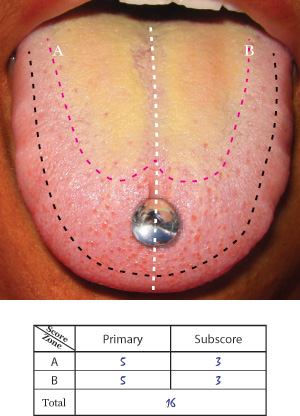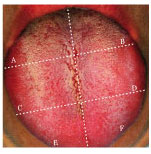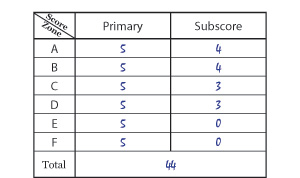April, 2017
Dear Colleagues,
Diagnosing oral malodor is intellectually challenging and often frustrating. There are numerous causes for malodor but most can be attributed to poor oral hygiene which results in accumulation of coating on the dorsum of the tongue. If the plaque and tongue coating are the main cause of the malodor, it can be corrected rather easily through patient education of oral hygiene. Numerous nights and days have gone into the development of the methods described here. I proudly introduce the Lee Tongue Coating (LTC) Index. Please review the material carefully and send me your comments. This will greatly help to improve and refine these LTC methods.
Tongue Coating Index
Observing the tongue and making assessments about the depth and breadth of a tongue’s coating is one method of making a gross judgment about potential malodor. While it sounds subjective, judging the tongue’s coating is considered a useful method of detecting oral malodor. Making a notation with regard to the characteristic color of the tongue coating is advised as well.
The Lee tongue coating index (LTCI) is a tool, among others, to quantify TC presence on the dorsal surface of a tongue. This index has its own unique notion; a double layer concept for thick TC which requires binary scoring. In addition, this index uses six scales, a 0-5 scoring system, for more refined increments as presented in Table 2-3: Lee Tongue Coating Index Scale.
LTCI1 utilizes no divided zones. LTCI2 consists of two equally divided zones on each side of the vertical center line. The dorsum of the tongue is divided into 3 equal zones for LTCI3. The grid consists of a parabola, which is intersected along the long axis by a dividing line. Four equal zones are formed from one vertical center line and one horizontal midline in the LTCI4. LTCI6 consists of one vertical and two horizontal lines. Each zone is marked with a white dotted line for visualization purposes as shown in Figure 2-9: Lee Tongue Coating Index and Appendix B: LTCI. A vertical line is included in LTCI2, LTCI3, LTCI4 and LTCI6 since it is easily discernible with minimal zoning error with each repetition. Another advantage is that the researchers and clinicians can reliably score the coating with the consistent framework of a coating index at the initial visit and all subsequent recall visits.
The LTCI is measured in two steps:
1) assign a primary score based on the overall TC surface coverage in each zone whether it is thin or thick;
2) then, assign a subscore based on the percentage of the tongue coverage that only has a thick coating. Following are the steps for assigning LCTI.
| Table 1b Lee Tongue Coating Index (LTC1) LTC 1= A+Thick Coating Score |
Table 1d Lee Tongue Coating Index (LTC2) LTC 2= A+B+Thick Coating Score |
 |
 |
| Table 1b Lee Tongue Coating Index (LTC4) LTC 4= A+B+C+D+Thick Coating Score |
Table 1d Lee Tongue Coating Index (LTC6) LTC 6= A+B+C+D+E+F+Thick Coating Score |
|
|
|
| Table 2 Lee Tongue Coating Index (LTC) Scale |
||
| Scoring Criteria Of Each Zone | Score For Primary Coating | Thick Coating (Subscore) |
| No tongue coating visible |
0 |
0 |
| Less than1/3 of each zone surface covered |
1 |
1 |
| More than 1/3 but less than 2/3 of tongue surface covered |
2 |
2 |
| More than 2/3 of tongue surface covered |
3 |
3 |
Even though LTC6 and LTC5 were developed for research and academic purposes and LTC4 and LTC3 were developed for everyday clinical purposes, one may select the method that best meets their needs. The reason for 4 different indexes is so that the clinician can select the appropriate indexing model based on the morphology of the tongue. One of the biggest advantages of these methods is that clinicians can easily and consistently reproduce the data. Score the coating consistently at the initial and all subsequent recall visits.
How to Score LTC
LTC involves assigning numeric values for four different sizes of tongue coating (shown as “Score for Primary Coating” in Table 2). Then determine the quality of tongue coating (“Thick Coating Subscore”) based on the thickness of coating at each zone (Table 2). This will be further explained below in Steps 1 & 2, and utilizing Tables 3 & 4.
The LTC index was developed based on two principles: assignment of a primary score based on the size of overall tongue coating (TC) (combining surface coverage of each zone), then the assignment (adding on) of a thick coating subscore based on the size of the thick TC coverage area alone. Clinically, a thick TC is best described by the example of hairy tongue. Visually, the surface of the tongue looks like a wet mop, sponge, or slime layer. Portions of this layer can be removed relatively easily by way of a tongue scraper or other such implement. The filliform papillae in a thickly coated tongue region are visually welldefined. Here is the procedure for determining a total score:
Step 1: Determine primary/overall score for the surface area of the coating
Whether the coating is thick or thin, the primary score is based on surface area TC coverage in each zone. In other words, the score is determined based on the visibility of the tongue surface area.Step 2: Determine the subscore for the surface area of the thick coating
This is the same as the primary scoring method except this applies for only thick TC areas of each zone. The quality of tongue coating is based on the thickness of coating at each zone (Table 2). It is reasonable to conclude that a thickly coated tongue region can contain double the amount of foreign substances including malodor-producing bacteria per unit surface area compared to that of a thinly coated tongue region. The thick layer can almost be considered a second layer over the primary layer. This is the fundamental reason for assigning a subscore. If the coating is thin to moderate, then no score is assigned. If the tongue coating is thick, a score is recorded as the subscore based on (Table 2).
For example: Using LTC, At Zone A, if the primary score is 3 based on surface area of TC and the quality (thickness) of the TC is considered thin to moderate in all the TC at zone A, the total LTC score is 3. At zone A, if the primary score is 3 based on overall surface area of TC, but the TC is also considered thick on half of the TC at zone A, then the subscore will be 2. So, the total LTC score will be 5 [primary score (3) + thick coating subscore (2) = LTC score (5)]. However, if the thick TC area were less than 1/3 of the TC of the TC at zone A, then the subscore will be 1. This would make the total score 4.
Final interpretation of the total score of LTC3 is summarized in (Table 3). Table 4 shows LTC Index Score-Dependent Treatment Recommendations.
Table 3 Final Total LTC3 Index Score Interpretation |
||
|
Score |
Clinical Appearance/Intensity | |
|
1,2 |
No tongue coating problem; normal tongue. Not likely odor source |
|
|
3,4,5 |
Mild tongue coating visible but transient or situational. If breath odor problem exists, tongue coating is not necessarily linked to it. |
|
|
6,7,8 |
Moderate tongue coatinl most likely contributing to breath odor. Coating should be suspected and investigated as a contributing source of a malodor problem. |
|
|
9≤ |
Heavy tongue coating likely is the contribiting to a malodor problem. |
|
Table 4 LTC3 Index Score-Dependent Treatment Recommendations |
||
|
Score |
Treatment/Action | |
|
1-3 |
Tongue coating is not likely to prevent or manage breath malodor as part of a daily oral hygiene regimen. |
|
|
3-6 |
Patient is advised to add daily tongue cleaning to oral hygieene regimen to determine if breath odor problem improves or is prevented. |
|
|
9≤ |
Daily tongue cleaning, before brushing/mouthwash use, advisable once or twice daily.. |
|
 |
 |
 |
 |
 |
 |
 |
 |
 |



